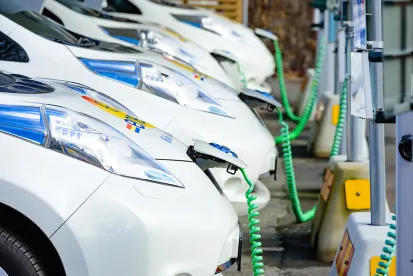Passed in August of this year, the Inflation Reduction Act (IRA) was heralded by many as a landmark piece of climate legislation in the United States. The IRA’s tax credits for electric vehicles were among its most anticipated benefits. The direct benefits appear to be slow in emerging. However, by strategically positioning their supply chains for duty savings that can be achieved through free trade agreements, as well as understanding how the special China tariffs work, companies that import and manufacture electric vehicles, automotive components, and related infrastructure products for the US marketplace are likely to gain a competitive edge for growing opportunities in this space.
The EV tax credits that ultimately materialized under the IRA may not have been the boon that many were hoping for. New eligibility requirements and restrictive sourcing provisions of the consumer EV tax credit appear to put the credit out of reach for many EVs. Even if an EV does qualify for the credit, income caps and MSRP requirements may further limit the number of consumers who can actually avail themselves of the credit.
Many stakeholders eagerly await proposed regulations and further guidance on how the EV tax credits will be implemented. As summarized in our client alert, Here Comes the Sun: Treasury and IRS Request Input on Solar and Other Energy Incentives Under the Inflation Reduction Act, on October 5, the Department of Treasury and the Internal Revenue Service (IRS) requested public input on the EV tax credits and other clean energy tax incentives found in the IRA, representing an important opportunity for the industry to weigh in.
It remains to be seen whether the regulations and other guidance will provide some flexibility for the EV industry in meeting the IRA’s requirements. Even if the IRA’s EV tax credits fall short of expectation, EV producers and suppliers are not necessarily out of luck. Strategic use of existing US trade rules and preferential trade programs could enable significant cost savings for these companies even without qualifying for the IRA’s tax credits.
This article goes over the basics of the IRA’s EV tax credits, some obvious (and not-so-obvious) questions raised by the language of the IRA, and what strategies can be pursued by companies to increase their competitiveness while operating under the realities of the EV global supply chain.
Background on the IRA’s EV Tax Credits
-
The IRA includes a tax credit of up to $7,500 at the point of sale for new EVs under Section 30D of the Internal Revenue Code (i.e., the consumer EV tax credit).
-
The IRA changed the eligibility criteria for the previously existing tax credit under Section 30D in several important ways, including requiring final assembly of the vehicle in North America, imposing income caps on taxpayers claiming the credit and MSRP limits on eligible vehicles, and placing certain sourcing restrictions on the components and critical minerals found in EV batteries of eligible vehicles.
-
Specifically, under the revised criteria, to be eligible for half the amount of the credit ($3,750), beginning in 2023, at least 50% of the value of the components of the EV battery must be manufactured or assembled in North America. This minimum threshold will rise in the following years up to 100% by 2029.
-
To be eligible for the other half of the total possible credit ($3,750), beginning in 2023, at least 40% of the critical mineral components of the EV battery must be extracted or processed in the United States or a country that is party to a US free trade agreement (FTA), or recycled in North America. This minimum threshold will continue to rise in the following years, up to 80% by 2027.
-
In addition, EVs with battery components or materials sourced from “foreign entities of concern,” such as China, are excluded from the Section 30D credit entirely after a certain phase-in period.
-
Used EVs are now eligible for a new credit of up to $4,000 (or 30% of the sales price of the vehicle, if lower), subject to different EV credit eligibility requirements under Section 25E, including income limits and prohibitions on an individual claiming the credit more than one time in a 3-year period. In addition, the used EV credit may only be claimed once per vehicle.
-
Commercial EVs are eligible for subject to difference EV credit eligibility requirements under Section 45W. Generally, the eligibility requirements are less stringent than the consumer EV tax credit and do not contain the same battery sourcing restrictions found under the Section 30D credit.
-
The IRA also includes an advanced manufacturing production credit for certain critical supply chain components and materials used in the clean energy industry (e.g., critical minerals, solar energy, and battery components) under Section 45X, as well as an investment tax credit for qualifying advanced energy projects (e.g., establishing a manufacturing facility for production of EVs or fuel cell vehicles) under Section 48C.
Lingering Questions
How will eligibility for the consumer EV tax credit be determined?
Many questions are raised by the IRA’s new eligibility criteria for the consumer EV tax credit. In particular, it is unclear how the minimum percentages based on value for the sourcing requirements on battery components and critical minerals will be calculated. The IRS appears to recognize this, specifically requesting public input on these issues under its notice. Among other things, the IRS is seeking feedback on which factors and definitions should be considered and whether any “existing regulatory frameworks” are available in making these determinations.
Here, the rules under US free trade agreements could provide the type of framework needed to implement some of these sourcing requirements. Many U.S. FTAs, including the U.S.-Mexico-Canada Agreement (USMCA) and the U.S.-Korea Free Trade Agreement (KORUS), contain similar provisions that set out minimum regional value content thresholds to claim benefits under the agreement, along with rules for making such calculations. These rules are already familiar to many companies in the EV industry that rely on the global supply chain to import components and materials, and have been regularly tested by courts and regulatory agencies over the decades.
While it remains unknown which regulatory framework the IRS will ultimately end up adopting with respect to these EV tax credits, the industry currently has an important opportunity to weigh in and provide input before proposed guidelines, and final rules are published.
Do the IRA’s North American production and sourcing requirements impact US commitments with the WTO and trading partners?
The European Union and South Korea have expressed concern that the IRA provisions run afoul of US commitments under certain WTO Agreements as well as certain US free trade agreements. Because the EV tax credits favor North American-assembled EVs with certain minimum North American sourcing requirements on battery components, the concern is that the IRA is providing discriminatory treatment against foreign made EVs in violation of those agreements. Some have predicted possible WTO challenges by trading partners such as South Korea, which is a major producer of EVs and could be negatively affected by the IRA’s EV tax credits. Currently, South Korean officials are working with their US counterparts to resolve their issues with the new EV tax credits.
If most EVs rely on the Chinese battery supply chain, will any EVs actually be eligible for the consumer EV credit?
At a high level, the EV tax credits and manufacturing credits work to incentivize US manufacturing of EVs and its battery supply chain in particular. The consumer EV tax credit also seeks to wean the US off the supply chain’s dependence on “entities of foreign concern” such as China. It does this by specifically excluding any EVs that would use batteries, including Chinese components or materials, after a certain phase-in period.
Currently, however, industry analysts note that China produces three-quarters of all lithium-ion batteries and between 70%-85% of the production capacity for key battery components. In particular, China is in control of the mid-stream portion of the supply chain, where the raw materials are processed into the active ingredients needed to make an EV battery. Because the US battery manufacturing industry is still in its nascent stages, the commercial reality is that many EV battery suppliers have no choice but to continue to rely on China for at least part of its battery supply chain.
What this means for the industry is that the consumer EV tax credit could be out of reach for many, if not most, EVs. The Alliance of Automotive Innovation estimates that by 2029, when the additional sourcing requirements go into full effect, none of the 72 EV models currently available for purchase in the US would qualify for the full credit.
A Bridge Solution: Potential Cost Savings for EV Producers and Suppliers Under US Trade Rules and Programs
Given the challenges of qualifying for the EV tax credits, what is an EV automaker or supplier to do? Certainly, other provisions in the IRA, such as the tax incentives found in Section 45X, help make attractive the prospect of US manufacturing of clean energy materials and products, such as EV battery components. However, some experts estimate that China has at least a 15 year head start on the manufacturing know-how and capacity necessary to produce EV batteries in numbers that are sufficient to meet demand. Only those companies that are able to stay ahead of the curve will be able to weather a less than fully localized US or North American battery supply chain.
EV automakers and suppliers who must rely on the global supply chain will need to find bridge solutions to remain competitive. Strategic application of US trade rules and programs can provide a unique opportunity for many of these companies, by saving on the cost of tariffs that might otherwise cut into a company’s margins. Notably, many of the EV battery components from China continue to be subject to additional tariffs of up to 25% under Section 301 trade remedy measures.
By understanding and utilizing the trade rules that govern the country of origin or tariff classification of an imported product or material, or qualifying products under FTAs such as the USMCA, EV companies that import and manufacture products for the US marketplace can remain competitive by reducing costs that might burden the company or be passed onto the consumer.
While it remains to be seen if the IRA is able to incentivize widespread EV adoption by the public, EV companies can leverage trade rules and programs now to gain an advantage in an increasingly competitive and unpredictable regulatory environment.







 />i
/>i

